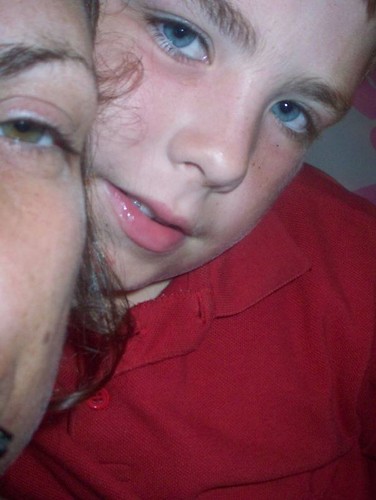BA/BSc (Hons) DESIGN for INTERACTIVE MEDIA (Top-up)
Module Number ADM306b
Year 2006-2007
Semester 1 & 2
Tutors WKB/DL/SN/SP/JPJ
Assignment Personal Project Pro Forma
Student name: Kirstie Willis
Student number: ST06003280
Email address: kustard99@hotmail.com
RESEARCH PAPER PRO FORMA
I. Your general field of enquiry
The general field of my enquiry will be of people who are sufferer from the condition Attention Deficit Hyperactivity Disorder (A.D.H.D) and Attention Deficit Disorder (A.D.D). The problems they face in their day-to-day lives and ways in which new media technologies especially in the area of Locative media can be used to enhance the lives of A.D.H.D/ A.D.D sufferers and improve their social skills. I’m also interested in researching the current issue of whether there are links between A.D.H.D/ A.D.D and creativity that is currently being debated
I suffer from A.D.D. myself so this project has personal meaning to me and will be beneficial to myself and other sufferers.
II. Your chosen subject
My research project will focus on sufferers of Attention Deficit Hyperactivity Disorder (A.D.H.D) and Attention Deficit Disorder (A.D.D). I intend to look at the links that sufferers have with creativity. I also intend to research ways in which new media technologies especially in the area of Locative media can be used to enhance the lives of A.D.H.D/ A.D.D sufferers. Looking at what assistive technology is presently available for people with A.D.H.D/ A.D.D
III. Your objectives. What are you going to document/uncover/ explain/question?
To uncover what research has already been done with regards to the links A.D.H.D/ A.D.D has with creativity and conduct my own research in this area.
To document research into the severity of the problems associated with A.D.D/ A.D.H.D such as inattention, memory, completing tasks, money and time management and poor social skills of sufferers and to look at ways that new media technology can improve them.
I am interested in developing an interactive device to enhance the social skills and lives of sufferers. I would like to investigate how the device could be location aware. The device should allow the user to map points and add notes in their locality and post messages for others thus building a location aware social network. The device will also have a memory minder, which will enable the user to remember events meetings phone calls etc.
I am hoping that if teenagers and young adults use these devices and build a social network of creative like minded people it will stop them feeling misunderstood and isolated which often causes them to get into trouble.
IV. A description and assessment of research base. Primary sources. Secondary sources.
Myself in the form of questionnaires online surveys and interviews will carry out primary research with people who have been diagnosed with the condition. I also want to survey people studying or working in the creative arts who have not been diagnosed.
Articles of interest on coaching ADD
V. An indication of your preferred methodology and why it is appropriate. What academic approach will you choose that is best suited to the analysis, contextualisation and cultural critique of your subject?
I will do a literature review of current research into the coincidence of creativity and A.D.H.D/ A.D.D
VI. References to key thinkers/academics
Cramond B The National Research Center on the Gifted and Talented, University of Connecticut.
VII. Indicative bibliography
Secondary research papers I have uncovered that are of interest to me are
Cramond, B. (1995). The coincidence of attention deficit hyperactivity disorder and creativity (RBDM 9508). Storrs, CT: The National Research Center on the Gifted and Talented, University of Connecticut.
Ackerman, C., "Identifying Gifted Adolescents using Personality Characteristics: Dabrowski's Overexcitabilities" June 1997, Roeper Review, Vol 19, No.4. (This paper has a nice chart comparing over excitabilities of gifted to average children).
Bachtold, L.M. (1982). Divergent thinking and temperamental traits. Psychological Reports, 51, 419-422.
Burcham, B., Carlson, L., & Milich, R. (1993). Promising school-based practices for students with attention deficit disorder. Exceptional Children, 60, 174-180.
Cramond, B. "The Association of ADHD and Creativity" 1995, The National Research Center on the Gifted and Talented. This entire paper is online!
Funk, J.B., Chessare, J.B., Weaver, M.T., & Exley, A.R. (1993). Attention deficit hyperactivity disorder, creativity, and the effects of methylphenidate. Pediatrics, 91, 816-819.
Gallagher, S.A. (1986). A comparison of the concept of overexcitabilites with measures of creativity and school achievement in sixth-grade students. Roeper Review, 8, 115-119.
Goertzel, V., Goertzel, M.G., & Goertzel, T. (1978). Three hundred eminent personalities: A psychosocial analysis of the famous. San Francisco: Jossey-Bass.
Pickering, G. (1974). Creative malady. New York: Dell.
Piechowski, M.M., & Cunningham, K. (1985). Patterns of overexcitability in a group of artists. The Journal of Creative Behavior, 19, 153-174.
Reid, B., et al. "Square Pegs in Round Holes --These Kids Don't Fit: High Ability Students With Behavioral Problems." The National Research Center on the Gifted and Talented, Sept. 1995.
Restak, R. (1993). The creative brain. In J. Brockman (Ed.), Creativity (pp. 164-175). New York: Touchstone.
Richards, R.L., & Kinney, D.K. (1990). Mood Swings and creativity. Creativity Research Journal, 3, 202-217.
Shaw, G.A. (1992). Hyperactivity and creativity: The tacit dimension. Bulletin of the Psychonomic Society, 30, 152-160.
West, T.G. (1991). In the mind's eye: Visual thinkers, gifted people with learning difficulties, computer images, and the ironies of creativity. Buffalo, NY: Prometheus Books.
VIII. Additional information that is relevant.
IX. Any questions you may have for staff.
Subscribe to:
Post Comments (Atom)


No comments:
Post a Comment